BOUND FOR THE EAST
By Martin Latimeri
Mr.Uno Orko was a man who could been be called as a big man. He was big in two ways; he was tall six and two, with large bulky and with red countenance and an earnest expression. He has a custom to looked straight into the eyes of the person to whom he was talking to, or who of he was listening.
The other thing made him even more big, was the large property that he had managed collect during his life time. He ran business as scrap yard , and he never neglected to mentions that he is a fair fellow who had started his career from the dump, and had been working with scrap since his youth.
It was wintertime when two tugs fell into hands of Mr. Uno Orko. Having little or nothing knowledge about business like nautical and seafaring he handled these tugs over to an agent who he supposed to know more about that kind of business.
The both tugs earlier had been in the service as harbour tugs in the port of Copenhagen had reached the turning point where the demand of the constantly increasing traffic in the harbour, - and the daily shortage of the horsepower, were cut them off and these old fashioned tugs had been replaced with modern and more powerful vessels.
The Fable was the smallest of these two vessels. She was a typical harbour tug with her low hull and narrow wheelhouse and was powered by the Mac, main engine of 1200 horsepower, She was very plain vessel, indeed. There were nautical apparatus on board as a VHF radio, the magnetic compass and the radar up there with the maximal range of six nautical miles.
She flew the Danish flag and was classed in the Germanisie Lloyds bearing class as A.1.which means that she was firm enough to travel in ice.
She was strong little vessel and I was appointed as skipper in her. Upon visiting aboard the vessel Mr, Orko said that the tug seems be in good condition and probably easy manoer because her wheel faced aft.
The agent said he have his connect in Moscow and had signed a contract directly with the minister of transport of the USSR which allowed him advantage to the business with assist with the every Russian ship caal at the port of Kotka the second eastern port of Finland.
“We musn't waste the time to putting this little vessel under way for Kotka to make money there.” he said.
I was young and eager to get underway. I had the crew aboard as the chief engineer, the mate and two sailors, no one of them as a seaman by their trade.
It was Tuesday and February and the winter was one of the hardest for a man’s memory and the ice that covered the sea was thick of a half a metre and in addition there was planket of white snow on it.
The day of departure was bright and sunny and the thermometer showed 15 degrees C, below the zero point.
We left the harbour of that small town on the west coast of Finland. There was no one on the wharf seeing us off as I carefully took her out of the quay, and put her around in the fast ice.
It took twenty six hour to reach the outer light-house Utц, standing on the outer edge of the frozen archipelago.
Because I was the only skilful navigator on-board the vessel (to tell the truth not so skilful and self-assured in that time) I decided take a pilot, so called long distance ice pilot. After couple hours waiting, the pilot came, full dressed and was smiling when boarding and found our means of transport being not much bigger than the pilot boat in which he was travelling. I heard his name, it was Lahtinen or something like that; I had forgotten the name within of an hour, for there was much other things to thinks and to be remember. If he was smiling upon boarding the tug, the voyage very soon wept away the smile from his slips and he remain rather po-faced until we were reached the destination.
Next day from the departure of Newstad we went out from the Uto and found the lean coloured sea clear of ice.
We were full bunkered and the aft-tank was filled with ballast water by meant to get the hull down to be avoid the propeller be damaged by ice.
We ran at full speed, first due south, then to east, keeping well offing from the grim sea cliffs. The wind was moderate from east and the low deck was washing lightly by the waves. Within the first hour the dusky shore line disappeared from sight and the radar did not indicate anything but empty water around.
At first there was a talk about to arrange the watch keeping in the wheel-house in turn, but when we had encountered the first drifting ice field, there was not a word to go below for rest.
We tried avoid ran into ice by altering the course several times, seeking for free water between the drifting ice floes. As the darkness desended the wind strengthened and there were the flying plashing in the air.
I asked the pilot whether he has any idea where we are; he said that after that kind of six sax steering no one could say anything sure about the position of the vessel without have an instrument to take a bearing from some well known point.
It was dawning increasing clear to us that we were lost. How sombre could be the grey cold sea with all these ice floes and flying plashing in darkness, it could only imagine. But worse was coming, for during the night we made frightening observation which revealed the fact that the vessel was carrying prolific ice cargo on her bow and on the superstructure, been forming from the prolifting flying spatters and plashing.
The growing ice on the vessel’s structure at open sea is inhumane thing and demand quickly decisions. We had to take her in lee if we would hope to see our home any more, but where going to? We even didn’t know our right position. How long she could last, nobody knew it. Many questions haunted in our mind as we stood in the dim wheelhouse. What to do. The refuge in a port in the coast, the thought was impossible and there was not other ship in sight nor was a smallest light in darkness.
Something white was looming ahead in the night. It appeared being a large field of drifting ice. Without waste the time we altered the course and headed direct into that drifting ice field, and stopped her as soon as we got out of the flying splashing, then started hammers the ice out of the bulk wards and from the wheelhouse’s walls.
Spending all night in the shelter of this grating ice-field we silently prayed in our minds that the ice-field could keep in the one piece until the wind will cased.
Then the wind cased before dawn and we continued our voyage keeping the course to east. Suddenly a glimpse of a light was seen, there was a ship. I hurried find the Addis and when found it sent out the A.A.A singala in the direction of the unknown ship, then asking; what ship?
Getting not answer of any kind I then hurried toward VHF and asked the ship who saw the light of Addis, to come on the canal 16.
“Was it you who showed the light?” Said the human voice on the canal 16
“it’s me," i replied with relax, then told taht we were seeking "contact”.
Without any other conversation the voice on the canal 16 burst out a fresh and long report of the situation of the ice.
When I was inquiring the position of his ship voice said. “Juts a minute.” then he gave red and green, and numerical values which I cannot remember any more. “Plenty ice anyway” the voice at last annouched.
I looked at the pilot who was bending over the chart table the pen in his hand ready to take up the position.
“Did you hear it? That fool gives us the Decca. We haven’t the Decca chart here.”
The pride of the seaman forbids us to make more questions about the position, so we continued our run keeping the course to east.
The next light belonged to a big ferry and it passed us so close that the bearing and distance we got from there, to the Nais-saari light house, was taken on the chart with great presumption.
The bearing indicated that we were accurate on the track. More for the good luck as skill of our own.
The VHF radio reached now a conversation between icebreaker Hansa and a cargo vessels somewhere out there.
The unseen icebreaker seemed shepherded by her radio all the vessels to assemble together within the point that situated ten mails from the Nais-saari lighthouse to west, to be reporting to the icebreaker every vessel arriving at the point.
We were hearing at full speed through the new light ice toward the point the icebreaker had ordered all ships to be assemble.
I took the phone and called the icebreaker and told them that we will arrival at the point within of hour and will join the convoy.
“What’re you net tonnage,”
“I think we have not net tonnage at all. This is a tug. I replied.
“The size of the tug and the engine’s power?
I let them know all that information belonging to our vessel classification and her ice class.
“You mustn’t be here. Your must go back were you are come from. We cannot assistance a small tugboat. Here is terrible pressure in the backed ice.
I deny reconciled the fact that we must turn around and re-enter the same way back and re encounters all those troubles again.
“No,” I said, it will be risky return the same way back. There is danger of get in ice,
And I couldn’t see any severe ice here which could hamper us to making headway.”
“Not a pace longer. I tell you, there is no ice, the ice is here”, said the voice from the icebreaker, “The real danger lies ahead . The eastern part of the gulf is blocked by backing ice, and we have to assist every single ship by towing them by one by one over the gulf to the Porkkalla. The only way eastward is the inshore passage made in fast ice on the northern coast. Stay there were you are”
We were waiting among the large ships the decision of the icebreaker, whether she will give us the change or not, whilst we dropped below get some coffee and were up again jut to heard the icebreaker calling the large cargo vessel laying not far from us.
“Did you see a small tug there? The radio said.
“Yes I can see here one small vessel like a fishing boat of something.”
“Is Fable her name”?
“Sound real fable.”
The Big icebreaker came and took as a swan take her young, making way for us and there were ice there , sometimes the main engine would stop because there was no water under the keel and there was high pressure of ice against the hull.
The pale faced pilot muttered by himself, “Even to my grandchildren I have to tell…
We were lucky enough to getting escaped from the grip of the packed ice, and before all we were lucky boys be still in life!!!
Sunday, 20 May 2007
Subscribe to:
Post Comments (Atom)


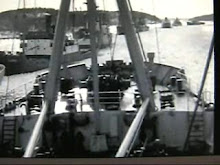
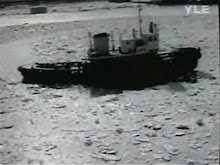
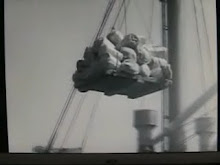
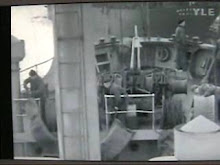


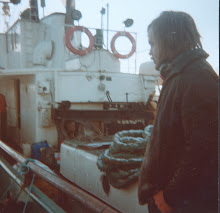
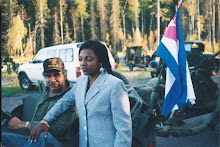








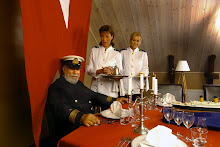
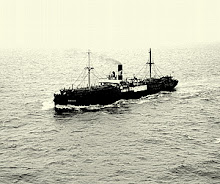


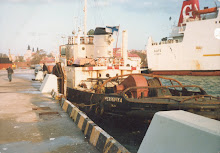
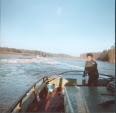



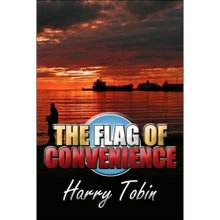







No comments:
Post a Comment
say what you want to say